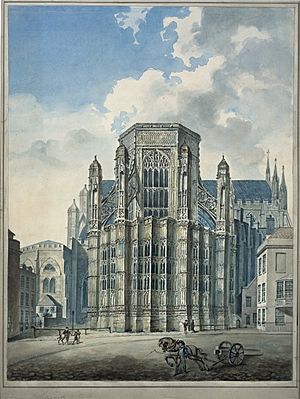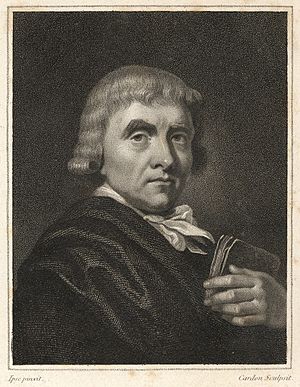Edward Edwards (painter) facts for kids
Edward Edwards (born March 7, 1738 – died December 19, 1806) was an English artist. He was a painter and also skilled at etching, which is a way of making prints. Edwards became a professor at the Royal Academy, teaching about perspective in art. He also wrote an important book called Anecdotes of Painters.
Life of Edward Edwards
Edward Edwards was born in London on March 7, 1738. His father was a chairmaker and carver who had moved to London from Shrewsbury. Edward was a sickly child and remained small throughout his life.
When he was young, he went to a French Protestant school. At age fifteen, he left school to help with his father's business. For three years, he worked for a cabinet maker, drawing patterns for furniture.
In 1759, when he was 21, Edwards was accepted as a student at the Duke of Richmond's art gallery. His father passed away in 1760, and Edward then had to support his mother and sister. He opened an evening school to teach drawing and earn money. He continued to support his sister until he died at 68. He was buried in St. Pancras churchyard.
Edwards was very good at etching. In 1792, he published a collection of 52 etchings. He also designed many illustrations for books. Besides art, he wrote poems and played the violin.
Artistic Works and Career
In 1761, Edward Edwards became a student at an academy in St Martin's Lane. There, he studied art by drawing from real life. By 1763, he was hired by John Boydell, a famous print publisher, to create drawings for engravings.
In 1764, Edwards won an award from the Society of Arts. He won for his historical painting called The Death of Tatius. He showed this painting at the Free Society of Artists. Later, he joined the Incorporated Society of Artists. However, he soon left to join the Royal Academy.
Edwards first showed his art at the Royal Academy in 1771. His paintings included The Angel appearing to Hagar and Ishmael and a portrait. He continued to show his work there until he died. Some of his notable paintings included:
- Bacchus and Ariadne (1773)
- Oliver protected by Orlando, from "As you like it" (1775)
- View of Brancepeth Castle, near Durham (1784)
- A View of the River at Barn Elms (1785)
- The Angel appearing to Gideon (1792)
- The Release of the Prisoners from Dorchester Gaol (1796)
- Portrait of Rev. H. Whitfield, D.D. (1799)
- Cupid and Psyche (1800)

In 1773, Edwards became an associate of the Royal Academy. The Society of Antiquaries of London hired him to draw a famous painting. This painting showed The Interview between Henry VIII and Francis I at Calais. The drawing took him six months to complete.
He also worked for other important people. Lord Bessborough hired him to fix a painted ceiling. Mr. Bell asked him to design illustrations for his Shakespeare books. With help from Robert Udny, Edwards traveled to Italy in 1775 to study art. He returned in 1776.
In 1782, he painted three ceilings for the Hon. Charles Hamilton in Bath. He also worked a lot for Horace Walpole at Strawberry Hill, making many drawings. In 1786, he painted a Hunting Party for Mr. Estcourt. This painting included portraits of the Duke of Beaufort and his sons. The next year, he painted scenes for a theater in Newcastle upon Tyne.
In 1788, Edwards became a professor of perspective at the Royal Academy. He later published a book about perspective. He spent a lot of time on a large painting called The Interior View of Westminster Abbey on the Commemoration of Handel. He showed this painting at the Royal Academy in 1793. In 1799, John Boydell asked him to paint a scene from Shakespeare's The Two Gentlemen of Verona.
Edwards also wrote a book called Anecdotes of Painters (1808). This book was meant to add to Walpole's earlier work. It contains valuable information about artists from his time that might have been lost otherwise. The book includes a portrait of Edwards, engraved by Cardon from his own drawing.
Images for kids
-
The Surrender of Calais to King Edward III (1776)
-
Mary Ann Yates as Cleopatra in Dryden's All for Love (1777)
-
Interior View of Westminster Abbey on the Commemoration of Handel (circa 1790)





